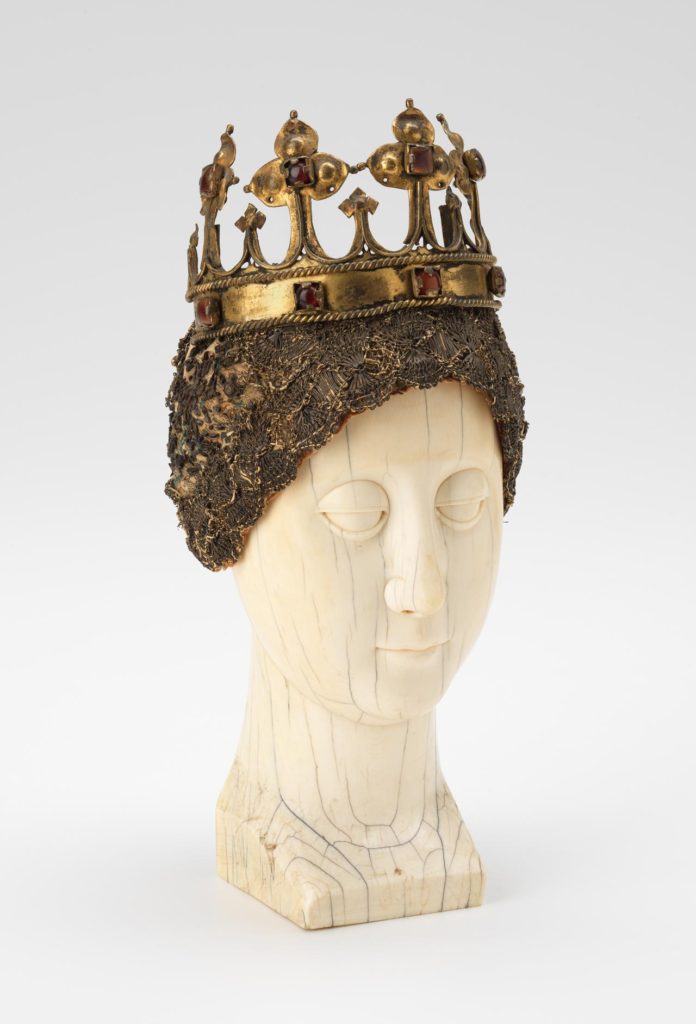This ivory sculpture depicting the head of the Virgin entered the collections of the National Gallery of Victoria in 1939 as part of the bequest of the English-Australian collector Mr Howard Spensley. He had acquired the sculpture in Vienna in 1934 from the art dealer Alexander Levai, who claimed that it had come out of a church in the town of Trumau in Lower Austria. When the work came to the NGV in 1939 it was catalogued as Spanish, of the sixteenth century, and sat within the European Decorative Arts collection.
The recorded provenance of this ivory head belies the fact that the sculpture is in fact of a type associated with exports from Manila in the Philippines between the sixteenth and eighteenth centuries. The head was originally a part of a kind of devotional sculpture known as an imagen de vestir (image to be dressed). These sculptures, intended to be carried in processions, consisted of heads and hands that were elaborated in detail, and affixed to a body that was generally a very simple wooden armature concealed by elaborate textile costumes. The sculpture’s dress varied according to the feast days of the ecclesiastical calendar. Such sculptures are well known in the Spanish tradition, especially in Seville and Andalusia where, during the seventeenth century, they played important roles in the devotions of lay confraternities. While the seventeenth-century Spanish examples were most often of wood or wood-paste with hyper-realistic polychromy, processional figures with ivory heads and hands were characteristic of the Spanish Philippines. Ivory body parts were exported in great numbers from Manila, via the Manila Galleon trade, to the Spanish Vice-regal territories in the Americas and from there to Europe. These body parts would be attached to wooden bodies at their final destination.
The first attested ivory imagen de vestir produced in Manila in the late sixteenth century is said to have been carved by a Chinese craftsman. Chinese ivory carvers are believed to have been responsible for the majority of ivory sculptures exported from the Philippines during the sixteenth to eighteenth centuries. This may explain the Asian aspects of the ivory Virgin’s physiognomy – the heavily-lidded, almond shaped eyes and the fleshy chin, both characteristics that have been linked to Buddhist iconographic traditions.
While many of the ivory sculptures exported from the Philippines were likely created by Chinese craftsmen resident in Manila employing African ivory imported via Portuguese trade networks, it is also possible that ivory carvings were imported into the Philippines from Portuguese Macau or Fujian province in Southern China; Manila was a major regional trading entrepot.
The presence of these ivory imágenes de vestir across the Spanish empire attests to the importance of images in Spanish missionary activities, but also to a widespread appreciation of the skill of Chinese ivory carvers and the beauty of their creations. The present head of the Virgin ended up in a church in Trumau, a town frequently visited by Emperor Leopold I (1640–1705) whose mother was a Spanish Infanta. This suggests that Hapsburg interest in exotica from across their colonial territories as emblematic of the dynasty’s power may explain this serene sculpture finding a home in Lower Austria, so far from its Asian point of origin. Here is a body (part) that has traversed the globe, mediating between a range of artistic traditions as it travelled. In one sense foreign everywhere it journeyed, we might also suggest that with every transference and recontextualization, our ivory head acquired a new identity that gave it meaning in its new home, calling into question the notion of foreignness itself.
Matthew Martin, University of Melbourne
